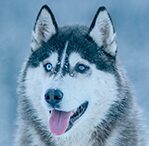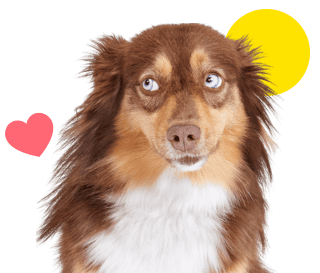
Meet the Siberian Husky
Best Workout Buddy
Mischievous Mutt
Best Fur Friend
If you’re looking for a high-energy dog with a big personality, I may be the breed for you! Siberian Huskies are some of the friendliest and most beautiful dogs around, but I’m not the right pup for a newbie dog owner. My human needs training experience (I’m stubborn!) and the time and energy for daily exercise. Some humans fall in love with our beauty without doing their research, so a lot of my brothers and sisters end up in shelters. Pawlease consider adoption if you can – we’re worth it!
Fair warning: I’m an escape artist so I need a fenced yard and should be leashed when we are out getting our walkies in. I’m a great dog for an athletic, nature-loving human and I’d pawsitively love to go on adventures with you. I’m not a good watchdog, though – I just love people too much! I don’t really get along with small animals (cats included) because I have a high prey drive, but I love kids and other dogs. I may seem like a lot of work but if you put in the time, I’ll be your friend furever!
Ready to learn more about me? Let’s dig in.
Ready to learn more about me? Let’s dig in.
 My Many Looks
My Many Looks

Black & White

Gray & White

Red & White

Sable & White
 My Breed Characteristics
My Breed Characteristics
 Furbulous Fact
Furbulous Fact
All of us Siberians have enchanting eyes, but while most of us have beautiful blues or browns, some have a furbulous mix of the two! Some Siberians have one blue eye and one brown eye, also known as bi-eyes or heterochromia. Some even have eyes that are a mix of blue and brown together, called parti-colored eyes. Parti-colored eyes are the rarest kind (5%), followed by bi-eyes (15%), with an equal number (40%) of blue- and brown-eyed beauties.
 As I Grow Up
As I Grow Up
As you can see, we Siberian Huskies age pretty gracefully. Here are a few key milestones in my growth and development to be aware of as I grow up from a pupper to an adult and senior!

Puppy2-6 Months
I am notoriously tricky to train so I need obedience training as early as pawssible so I learn you are the alpha of my pack.

Adult1.5-2 Years
Make sure I get a lot of daily exercise and mental stimulation – I get destructive when I’m bored, so tire me out!

Senior8-9 Years
I may be slowing down, but I still need daily exercise, just not as much (but keep an eye out for signs of arthritis).
 History of My Breed
History of My Breed
We Siberian Huskies come from – you guessed it! – Siberia. My ancestors were working dogs bred by the Chukchi people of northeast Asia. We were (and still are!) excellent sled dogs, and my ancestors were bred to travel long distances over ice and snow in subzero temperatures. The Chukchi people lived where food was scarce and they needed to travel to the sea to hunt. My ancestors hauled food like walrus meat from the Arctic Sea across the tundra. Since our entire bodies are built to withstand the cold, my ancestors could help their humans do the same by cuddling up with them for warmth. They formed a very close bond with their humans (especially the women and children), which is why we are such good family pets today!
Siberian Huskies made their way to America in 1909 when a Russian fur trader named William Goosak brought a group of us to Alaska during the gold rush. Because we were such excellent sled dogs, Goosak entered the All-Alaska Sweepstakes race and his team of Siberians came in third place, beating many teams of the native sled dog breed, the Alaskan Malamute.
We became world famous in 1925 when a heroic group of Siberians saved the day. There was an outbreak of diphtheria in Nome, Alaska, and the closest cure was over 650 miles away. Leonhard Seppala drove a brave pack of Siberians across the ice and snow and reached the people of Nome with the cure in less than 6 days. Balto, the lead dog for the final part of the trip, became the most famous Siberian in the world. There is a statue of him in New York City’s Central Park, and Disney made Balto (1995) based on his life. The American Kennel Club officially recognized us in 1930. These days we’re more of a companion dog than a working dog, but whether we're pulling a sled or enjoying a long snowy hike with our humans, we’re one of America’s most popular breeds!
 Pawesome Pups to Parent
Pawesome Pups to Parent
In addition to purebred Siberian Huskies like me, there are tons of pawfectly sweet mixed-breed Huskies that are looking to find their furever homes. You can learn where to find your next pet below!
 Care Tips
from Dr. Stacy Choczynski, Veterinarian
Care Tips
from Dr. Stacy Choczynski, Veterinarian 
Play with the paws and tail daily.
Huskies can be sensitive about their tails and paws. To allow for successful vet checks, paw health, and nail maintenance, touch these body parts daily while providing a positive reward like treats and calm praise.
Plan on a yearly check up.
At your Husky’s wellness visit, inquire about your pet’s eye, joint, and skin health. Your veterinarian may even recommend a glucosamine or fish oil supplement to promote excellent joint and skin health.
Brush the carnassial teeth.
Huskies tend to keep their teeth fairly clean through chewing but often develop dental calculus on their carnassial teeth. Pet parents can help with dental health by brushing the largest premolar tooth on the upper arcade (and then move on to brush the other teeth too).
 Training Tips
from Trainers & Behavioral Specialists
Training Tips
from Trainers & Behavioral Specialists

Plan on AT LEAST 1-2 hours of daily exercise.
Siberian Huskies need to go on long runs to get their energy out. If you don’t allow a Husky to expend their energy, you will get a dog that is bored and destructive. Huskies are a working breed and they need an owner that has time to take them on very long walks and runs or trips to a dog park to release their energy on a daily basis. - Diana Ludwiczak
Huskies can be stubborn – train them early!
Siberian huskies are extremely independent and high-energy dogs. It's important to start training early, instilling a lot of obedience, giving them plenty of exercise, and especially focusing on solid recall as they are notorious for running away/escaping areas. The key obedience commands to teach a Husky are heeling on leash, sit, down, stay, and come. - Lena Abuarafeh
Keep your Husky’s mind as active as their body.
Siberian Huskies are working dogs who need a lot of mental stimulation. They can be highly motivated either by food rewards or toys and are incredibly intelligent dogs. The more exercise and mental stimulation you give a husky, the better off they will be. - Lena Abuarafeh

 Why Get Dog Insurance?
from Pumpkin®
Why Get Dog Insurance?
from Pumpkin®
While Siberian Huskies are a generally healthy breed, unexpected ruh-rohs can happen to any dog at any age. If your pup gets hurt or sick, pet insurance can help you say ‘yes’ to the best care, even when it’s costly. When it comes to shopping for your breed, you’ll want to choose insurance plans like Pumpkin's, which can help cover the costs associated with the hereditary conditions Huskies are prone to developing. While a reputable breeder will conduct genetic testing on your pup’s parents to help minimize the chances of passing down hereditary conditions, they can’t always be avoided. Let’s look at some common ones, and how Pumpkin Dog Insurance plans could help cover the cost of care!
 Hip Dysplasia
Hip Dysplasia
An orthopedic condition where the ball and socket of the hip joint don’t develop or work properly, leading to joint deterioration, pain, lameness, and/or arthritis. While mild cases can be managed with prescription meds and physical therapy, severe ones may require costly hip replacement surgery.
- Cost to Treat
- $1,500-$7,000 (surgical)
- Pumpkin Pays Back*
- $1,350-$6,300
 Cataracts
Cataracts
Aussies are prone to many genetic eye conditions, including cataracts. These opacities that form on the lens of the eye can show up as early as age 2, or more commonly in aging adults. Depending on the rate of progression, vision impairment may be mild, or severe and call for costly surgery.
- Cost to Treat
- $2,600-$3,800 (surgical)
- Pumpkin Pays Back*
- $2,340-$3,420
 Periodontal Disease
Periodontal Disease
Siberians are prone to dental problems that lead to periodontal (gum) disease. When plaque builds up and forms a layer of tartar, it inflames the gums. Left untreated, gums weaken and separate from teeth. While routine brushing, cleanings, and antibiotic gels help treat milder cases, severe ones require surgery.
- Cost to Treat
- $500-$2,500
- Pumpkin Pays Back*
- $450-$2,500
 Hypothyroidism
Hypothyroidism
Siberians are prone to developing hypothyroidism, which occurs when a dog’s thyroid gland is underactive. This slows down their metabolism, which negatively affects all major organ functions. This condition can be treated (but not cured) with thyroid replacement hormone therapy for the remainder of a dog’s life.
- Cost to Treat
- $300-$5,000
- Pumpkin Pays Back*
- $270-$4,050
*Example illustrates reimbursement of a covered vet bill at a 90% reimbursement rate, where the annual deductible had already been satisfied and the annual limit had not yet been met. Coverage and reimbursement results vary based on policy options.




